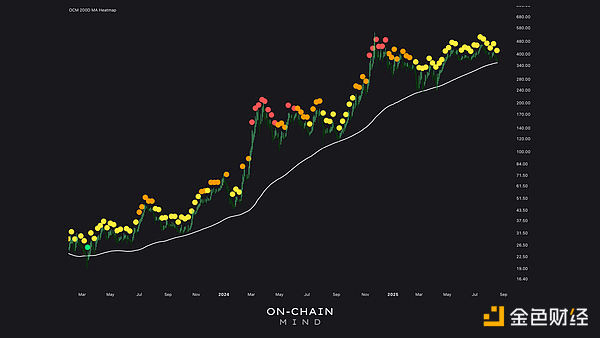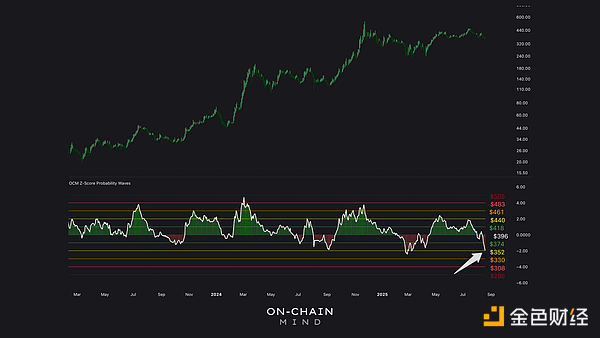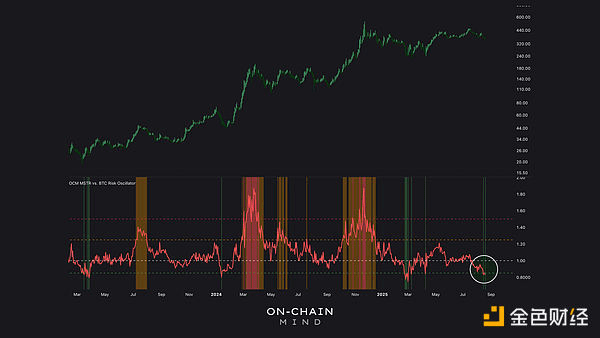Author: On-Chain Mind
Translation: Shaw Gold Finance
There are concepts in finance that most of us accept without ever questioning. For example, P/E ratios, 'fair value' metrics, or even the belief that the value of money itself will remain stable. But when you step back and think about it, some of these ideas begin to look less like immutable natural laws and more like collective beliefs supported by tradition.
This article delves into the concepts of Strategy (MSTR), market value to net asset value ratio (mNAV), and how these concepts adapt to the evolving world of Bitcoin-centric companies. It provides a more fundamental and philosophical view of this new type of company, linking familiar ideas from traditional finance (TradFi) while questioning many assumptions that investors take for granted.
Ultimately, you will understand that companies like MSTR are not just 'buying Bitcoin' — they are reshaping the potential landscape of stock value in the next decade.
Let's get started.
Key Points Overview
Challenging traditional metrics: Free Cash Flow per Share (FCF/Share) is the 'North Star' of traditional stock investing, closely resembling the per Bitcoin value in companies holding Bitcoin reserves.
The power of growth narratives: Investors bet on long-term growth, even with many unknowns, which complements Bitcoin's exceptional compound growth rate.
mNAV is the 'new P/E ratio': It is not only a valuation tool but also indicates operational strength, financing ability, and investor confidence in Bitcoin holdings.
MSTR's technical signals: Indicators such as the 200-day chart and Z-score probability waves suggest that the company's current price of around $350 is a very attractive entry point.
FCF/Share: The North Star of traditional investing
When simplifying the essence of stock investment, one metric often stands out: Free Cash Flow per Share (FCF/Share).
Why? Because free cash flow represents the actual cash generated by a company after paying operating expenses and capital investments.
Free Cash Flow per Share is often seen as the ultimate metric for measuring a stock's effectiveness in returning capital to shareholders, whether through dividends, buybacks, or reinvestment. A sustained annual growth rate of 15% in Free Cash Flow per Share is typically referred to as 'exceptional,' as compounding at this rate means the stock's value roughly doubles every five years — a feat few companies worldwide can consistently achieve.
This is why the market gives such companies premium valuations, typically with P/E ratios between 25 and 30 times. In some cases, investors can even accept P/E ratios of over 100 times. At first glance, this seems absurd — many companies do not survive to see their expected returns. But the reason is simple: growth. If the story is compelling enough, investors will be willing to pay a high price.
The madness of high P/E ratios
Willingness to pay extremely high P/E ratios for profitability is one of the widely accepted quirks in the investment field. Few stop to think about the reasons behind it. But when you step back, you realize people are essentially betting on an unknowable future.
Will this company still exist in 25 years?
Will it still dominate its industry?
Will the compound growth of earnings continue uninterrupted?
Despite these uncertainties, the growth narrative itself has become a currency. The market holds it as a standard.
The reason being, if many people believe in a company's growth, this belief can drive its stock price up significantly over the coming years. This concept is widely accepted in the investment community, but when you break it down simply and think it through philosophically, you’ll find it’s quite crazy.
The rise of mNAV
Now, let's apply this logic to Bitcoin treasury reserve companies. Currently, the same concept is playing out in the Bitcoin reserve company space. mNAV (market value to net asset value ratio) is the 'premium' investors pay for a company to acquire more Bitcoin in a way that they themselves cannot achieve efficiently.
I like to compare it to the P/E ratio of the 'new era' (price to earnings ratio). In fact, conceptually, it is more similar to the price-to-book ratio (price to book value ratio), although this term is less familiar to ordinary investors. Interestingly, the current price-to-book ratio of the S&P 500 Index is about 5.4 times, with historical fluctuations ranging from 1.5 to 5.5, remarkably similar to MSTR's historical average mNAV.
The price-to-book ratio measures the relationship between a company's market value and its book value (assets minus liabilities). It indicates how much investors are paying for each dollar of net assets.
It is truly refreshing to see many investors questioning why we should pay a premium for underlying Bitcoin assets, rather than blindly accepting this concept as is common in many aspects of traditional finance. We should question why things are priced this way. I believe this is a huge advantage for ordinary Bitcoin investors: the ability to challenge widely accepted opinions simply because 'that's how it's always been done.'
Why does a Bitcoin premium exist?
Trust growth plans — companies will find ways to ensure their portfolio's growth outpaces individuals.
Access to cheap capital — this is something ordinary investors can never aspire to.
Operational leverage — achieving faster expansion through structures like convertible bonds or equity financing.
Can you get a loan at around 0% interest to accumulate more Bitcoin? Almost impossible. This is where the strength of the best Bitcoin reserve companies, particularly larger and more committed ones like Strategy (MSTR), lies.
Specifically, companies like MSTR utilize convertible bonds, where lenders accept lower interest rates in exchange for equity conversion rights. This effectively subsidizes the accumulation of Bitcoin. In traditional finance, this is similar to how tech growth companies use leverage to scale without immediately diluting equity.
But if a 15% annual growth rate in Free Cash Flow per share for traditional financial stocks is considered 'exceptionally outstanding,' then why do we assign a 1.5 times premium (or a 4 to 5 times premium) to companies like MSTR holding Bitcoin, knowing that Bitcoin has had a compound annual growth rate of 60% to 80% over the past 5 to 10 years?
I believe this is a major concept that the broader investment community has yet to grasp; they still generally do not understand that Bitcoin is one of the top five global assets and is gradually consuming global capital value. This is also a significant reason why I remain bullish on companies like MSTR in the long run.
mNAV discount: traps and real signals
So, can a company trade at an mNAV below 1? Absolutely. According to Bitcoin Treasuries statistics, among 167 listed companies, 21 (about 13%) are trading at a discounted mNAV.
This is very similar to why some stocks trade at extremely low P/E ratios, such as 5 times P/E. Many traditional financial investors fall into this 'value trap,' believing they have bought a bargain at a very low price because the stock price is low. But in reality, the reason most of the time that stock prices are low is that the company has failed to deliver the performance investors expected.
I believe the concept of value traps also applies to Bitcoin reserve companies. For those trading at a discounted mNAV, this indicates skepticism from the market, which may be related to the following factors:
Weak governance;
Fragile financing model;
Current business operational risks.
In fact, this may also indicate that investors are confident in these companies' ability to hold Bitcoin. Because, from a mathematical perspective, when mNAV is below 1, the favorable action for the company's shareholders is to sell Bitcoin to repurchase stock.
But companies like MSTR have resisted this temptation. Even during the bear market of 2022, when its mNAV fell below 1, they preserved their entire Bitcoin holdings by restructuring debt. That’s why I’m quite confident MSTR will not fall into this category. I have no doubt they will continue to hold all their Bitcoins even under less favorable conditions. This long-term holding philosophy stems from Michael Saylor's vision of viewing Bitcoin purely as collateral.
I do not have much confidence in the other 166 listed companies. The only one I would categorize as 'HODL long-term hold' is Metaplanet in Japan.
Thus, mNAV is not simply a buy or sell signal — it is a perspective. A premium may indicate strong confidence or just hype, while a discount may reflect distress or contain value. The key lies in the specific circumstances:
How much has the company increased its Bitcoin per share?
Does it have other income sources to support its valuation?
How resilient is its funding model during market cycles?
MSTR's financial magic
What truly sets MSTR apart from many other Bitcoin reserve companies is its diversified fiat financing ability, which effectively allows for the purchase of its held Bitcoin assets. Its low-cost financing tools, such as convertible bonds, and an expanding list of preferred stock offerings enable it to increase its Bitcoin holdings more rapidly without diluting the equity of common MSTR shareholders.
For example, convertible bonds allow borrowing at close to zero effective interest rates during bull markets when converted to equity. This forms a flywheel: more Bitcoin increases collateral value, allowing for more borrowing. In my view, this financial magic deserves a significant premium. Just as Nvidia commands a reasonable P/E ratio due to its growth rate in Free Cash Flow per Share far exceeding that of almost all other companies in traditional finance.
For most, this is a completely new concept. Bitcoin reserve companies aim to increase the number of Bitcoins per share as quickly as possible, while traditional finance companies seek to maximize Free Cash Flow per share as fast as possible. It’s the same idea. One side aims to grow a pure capital that appreciates at least 30% to 50% annually for the foreseeable future, while the other tries to accumulate their favorite fiat currency, which depreciates at 8% to 10% each year.
I know which company is more likely to create more value for shareholders in ten years, given their respective strategic developments.
Market signals
Finally, let's quickly browse some charts to discover potential value opportunities.
The 200-day chart signal shows strength: MSTR is expected to present a green signal point on the 200-day chart for the second time in this cycle, with its trading price at the 200-day moving average of $353. This level is a critical support point for bulls, marking the beginning of this bullish momentum. If it can stabilize at this price, it may indicate strong upward potential.

Z-score probability wave: MSTR's stock price has fallen to a level of negative 2 standard deviations, precisely at $353. Historically, when stock prices fall below negative 1 standard deviation during this bull market, it often indicates significant price fluctuations, and if the macro situation remains optimistic, the stock price is likely to revert to the mean.

Oversold condition: My mean reversion oscillation indicator (which operates similarly to the RSI) shows MSTR is in a deep oversold area. Historically, instances at this level often lead to short-term rebounds and sometimes significant upward movements.

MSTR investment opportunity priced in Bitcoin: When priced in Bitcoin, MSTR's risk oscillation indicators are at one of their lowest values, providing a strong signal for investors in a low tax rate environment to shift investments from Bitcoin to MSTR. Historically, this lag in MSTR's stock price relative to Bitcoin often gets quickly corrected.

Why MSTR's stock price lagging does not worry me
In summary, am I worried that MSTR's stock price is lagging behind Bitcoin's current surge? Not at all. Currently, mNAV may have compressed to about 1.5, but the true measure of its Bitcoin strategy remains intact: the number of Bitcoins per share is still increasing weekly. To a large extent, that is all I care about.
Just like traditional stocks, their Free Cash Flow per share may increase year after year, but stock prices may fluctuate wildly. This is the fascinating aspect of irrational investor psychology. However, if the fundamentals continue to improve (such as the increasing number of Bitcoins per share), I would eagerly seize the opportunity to buy this company at a discount. Because as we know, when investor sentiment shifts and the P/E ratio eventually expands again, this stock has the potential to yield significant profits.

